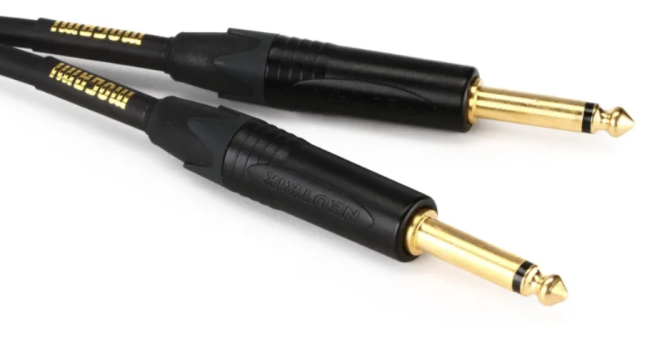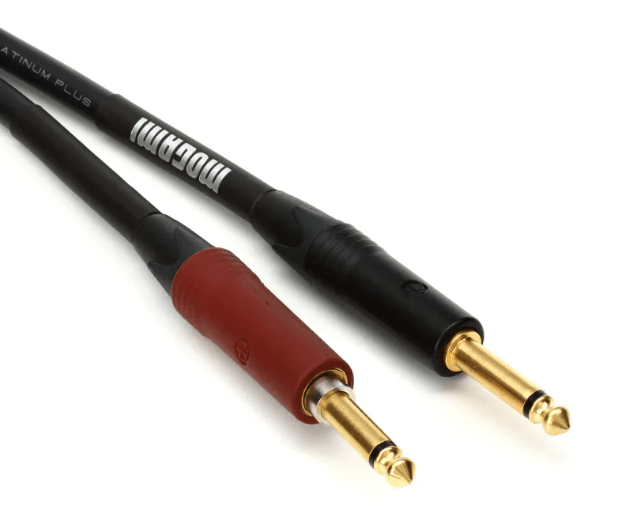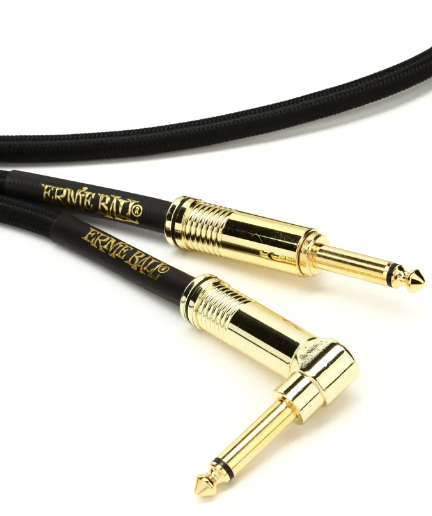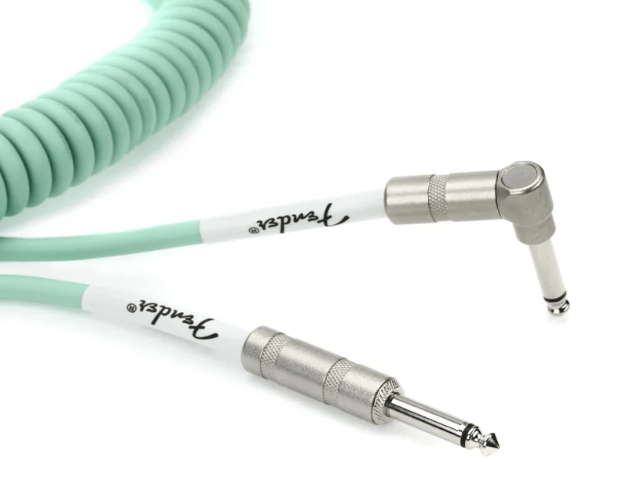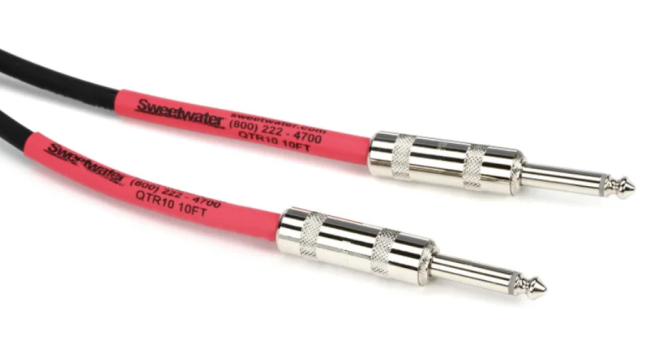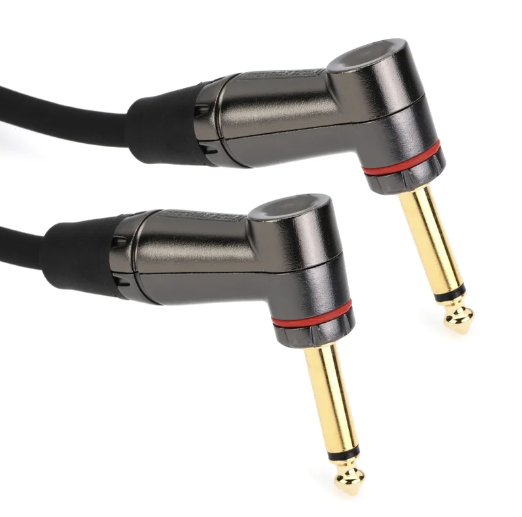We guitar players are notoriously picky about our tone, and we'll try anything in pursuit of the sound in our heads. Like testing out any axe we can get our hands on, endlessly hunting for the “sweet spot” on our amps, swapping out pickups, and when it comes to pedals…you get it.
Cables are one of the most important elements of good guitar tone, yet they're often the last piece taken into consideration. Buy a lower-quality cable, and you compromise all the hard work you've put in on your tone. Plus, you'll just be buying another one in a year.
I've tested tons of guitar cables in search of the best ones on the market today, and my clear favorite is the Mogami Gold Instrument line. Stellar craftsmanship, high-density shielding, and gold Neutrik connectors set it apart. And it’s a great balance of value and relative affordability in a top-shelf quality cable.
Let’s explore some of our top picks for the best guitar cables and some of the things to look for when shopping around for the best ones for your rig.
Quick Summary of the 6 Best Guitar Cables of 2024
- Mogami Gold Instrument (Best Overall)
- Mogami Platinum (Best Premium Guitar Cable)
- Ernie Ball Braided (Best Braided Guitar Cable)
- Fender Original Series Coil Cable (Best Coiled Guitar Cable)
- Pro Co EG (Best Budget Guitar Cable)
- Gator Cableworks Headliner Series (Best Patch Cable)
6 Best Guitar Cables of 2024
Best Guitar Cable Overall
SPECS:
Length: 3’, 6’, 10’, 18’, 25’
Connector 1: Neutrik TS ¼” male straight
Connector 2: Neutrik TS ¼” male straight or right angle
Mogami is thought of as the Rolls Royce of guitar cables, and for good reason. They sound great, they’re high quality, durable, and on professional stages the world over.
The instrument cable is the lifeline between the guitar and whatever comes after it. Whether that’s a traditional audio signal flow that eventually ends up at the amplifier, or going direct to an interface or console.
Built on Mogami’s 2524 cabling, they took great care in designing the Gold line. From the transparent-sounding oxygen-free copper core to the carbon-impregnated PVC shell, to the high-density spiral shield and conductive polymer subshielding, these cables are premium quality all the way.
Clarity in a high-quality guitar cable doesn’t get better than this. The low-loss signal transfer and low noise are perfect for runs longer than 20 feet where capacitance and interference can become concerns.
We admit this is really expensive for a guitar cable. But no matter what you need it for, this is a top-of-the-line unbalanced cable with high-quality construction and pure signal to match its price tag.
As far as the best guitar cables are concerned, this model from Mogami is the gold standard.
Best Premium Guitar Cable
Superior craftsmanship with silent hot swapping.
SPECS:
Length: 3’, 6’, 12’, 20’, 30’, 40’
Connector 1: Neutrik TS ¼” male straight or right angle (depending on length)
Connector 2: Neutrik TS ¼” male straight or right angle (depending on length)
Another top-shelf offering from Mogami is their high-end Platinum series. An ultra-high-density copper spiral shield provides 100% coverage against RF and electromagnetic interference, and it’s outfitted with a conductive PVC shell, cellular polyethylene insulation, and oxygen-free copper core.
But by far the most interesting feature is the Neutrik Silent Play connectors. They let you hot-swap guitars while the instrument cable is live. This isn’t just useful for switching guitars quickly during a set without needing to mute, but it also protects against dreaded popping if the cable gets disconnected accidentally.
Every guitar player can benefit from Mogami’s Platinum Guitar series of premium cables. It's far from the cheapest cable, but if you are looking to invest in one of the best guitar cables this should be the first you consider.
Best Braided Guitar Cable
High fidelity, low noise, affordable
SPECS:
Length: 10’, 18’, 25’,
Connector 1: TS male ¼” straight or right angle
Connector 2: TS male ¼” straight or right angle
Ernie Ball is famous for making guitar accessories that are well-made and affordable for the average musician.
To provide the least amount of noise and increase lifespan it’s got a dual braided copper shielding and conductor design. Guitar cables are subject to a lot of environmental abuse, and oxygen-free copper at a 99.95% rating helps to prevent corrosion.
You can get it in any connector configuration and in a variety of colors. With the Ernie Ball braided instrument cable, you don’t have to sacrifice sound quality for affordability.
Best Coiled Guitar Cable
A classic retro look with the right features.
SPECS:
Length: 30’
Connector 1: TS male ¼” straight
Connector 2: TS male ¼” right angle
If you’ve heard the rumor that coiled cables reduce interference, or they somehow sound different than straight cables, it’s just not true. But they do offer some advantages that a straight instrument cable doesn't in terms of utility.
For starters, they have a distinct, vintage look compared to a straight guitar cable, they are less of a tripping hazard and are more flexible than straight cables. In general, their lifespan is also increased, as long as they’re taken care of.
There are a few different versions of Fender’s Original Series Coil Cable, including a classy Tweed and purple Jimi Hendrix Voodoo Child options. It comes in other classic Fender aesthetics like '60s pastels, or simple black and white.
One connector is straight and the other is a right angle, another space-saving benefit. The style doesn’t appeal to all guitarists, but as far as coiled designs go it's one of the best guitar cables. There’s just something cool about coiled cables. Maybe it’s the Jimi Hendrix effect.
SPECS:
Length: 6”, 1’, 1.5’, 2’, 5’, 10’, 15’, 20’, 25’, 30’, 50’
Connector 1: Neutrik TS male ¼” straight or right angle
Connector 2: Neutrik TS male ¼” straight or right angle
Ask ten guitarists what they think of cheap guitar cables and you’ll likely get 10 different answers. But inexpensive doesn't necessarily mean low quality. The reality is that affordable cables are designed to meet working guitarists wherever they are.
Their EG series could be considered a budget line, but while it’s wallet-friendly they don’t skimp on the details that make a guitar cable great. Neutrik connectors provide the kind of reliability that stands up to the rigors of the road.
Dual shielding of the 20 AWG wire and construction keeps out noise and interference while the cable jackets have the flexibility that working guitar players demand.
The line comes in a variety of different lengths, and you can choose what connector standards best suit your rig. Breakdowns are an inevitability no matter what type of guitar cable you use.
With Pro Co’s lifetime warranty, you can plug back in and get on with the show in no time! Just because you use budget guitar cables doesn't mean you have to sacrifice your sound to outfit your rig with the best guitar cables.
Best Patch Guitar Cable
SPECS:
Length: 6”, 3’, 10’, 20’, 25’, 30’
Connector 1: Gold-plated TS male ¼” straight or right angle
Connector 2: Gold-plated TS male ¼” straight or right angle
The term “patch cable” can refer to any length of instrument cables, but it’s mostly used as vernacular for a shorter run designed to connect guitar pedals and rack mount effects together. With Gator’s Cableworks Headliner Series you have multiple length options, with the shortest being six inches.
It’s constructed with all the standards of high-end guitar cabling like a 99% oxygen-free copper conductor, braided shielding to reject interference, and a flexible soft PVC jacket.
The gold-plated connectors offer reliable conductivity and fight corrosion. And they come in all configurations, including straight to right angle.
But the feature that stands out is the TORIColor ID identification system. Even in small signal flow rigs cabling can get out of hand quickly.
This system provides an easy way to identify which individual cables are going where. Better than gaff tape and a Sharpie, right?
6 Best Guitar Cables of 2024 Buyer’s Guide
Guitar cable features are simple, but there are still things to take into consideration when you’re shopping around for the best choice for your rig. Keep these things in mind and it won’t be difficult to narrow down your options when you're looking for a good cable.
Length
Length is one of the most important factors to think about when shopping for guitar cables. It especially confuses novice players because they tend to want as much range as possible. But since guitar cables are unbalanced, TS (tip sleeve) cables, they have no ring element like balanced TRS or XLR cables do.
This means the longer the length of the cable, the more capacitance and interference creeps in. Cable capacitance is a degradation in the high midrange and high frequencies. It’s also known in guitar player slang as “guitar tone suck”.
It’s not just the cable running from the guitar either. Even a modest pedalboard or rack setup has a few pieces of hardware. Considering the overall cable length it takes to connect them and then send the signal out to whatever comes after it, those inches add up. That’s where capacitance and frequency response issues creep in.
Obviously, guitarists need a useful amount of cable length into their amp, or into their pedalboard and then into the amplifier. The general rule for the best guitar cable length is to not go with runs longer than 20 feet. Bigger stages make this even more difficult.
So why do so many companies offer unbalanced cables much longer than that?
Cable craftsmanship has gotten a lot better over the years. Build elements like better shielding and core materials help preserve guitar tone over longer lengths. But unbalanced is unbalanced. Environmental factors like quality of electricity, electromagnetic interference, even fluorescent lighting all have an effect.
If you want to use longer runs you should, but pay attention to your sound. Those short cables connecting pedals and rack gear add up, and tone suck is very real. No guitarist wants to sound like there’s a blanket over their amp!
Wire Gauge
The gauge used in manufacturing guitar cables directly affects signal strength and overall durability. But the quality of the wire is one of the most important cable features.
There is no “best” gauge, but in general the thicker the gauge the better conductivity it has. So something around 20 AWG is a good median point.
Different manufacturers use different gauges, but in general you’ll find they use something between 18 and 24. And remember, if you don’t take proper care of your cables, wire gauge won’t affect how long they last.
Shielding
Shielding is one of the most important cable features. Instrument cables are an unbalanced, TS (tip sleeve) design. The shielding/sleeve element protects against electromagnetic interference. It’s one of the most vital parts of a guitar cable to keep out unwanted noise, but it’s not a bulletproof solution.
Environmental factors and length of the cable play a role in the fidelity of the signal. The former are things like the quality of electricity being fed to the rig. While guitar cables come in many different lengths, it’s best to keep them to 20 feet or less.
It can be tough to keep leads short for live performances, especially on bigger stages. Using a longer cable length doesn’t necessarily equate to more interference, but it does increase the possibility.
And when working in recording studios try to keep the main leads from guitar to effects and effects to amp to the shortest runs possible. Ten feet is a good standard. Longer cable runs also introduce capacitance, which is a loss of high end. Experiment with different lengths to find the best compromise for your rig.
Connectors
The quality and material of a guitar cable connector affect conductivity and longevity. Gold-plated connectors are considered to be top-of-the-line because they provide better connectivity and are more resistant to corrosion than chrome or nickel-plated connectors.
Companies like Neutrik and Amphenol make some of the best guitar cable connectors, but just because a cable has unbranded connectors doesn’t necessarily mean you’ll experience issues with them.
Durability and Flexibility
These are two of the most important elements of a guitar cable’s design. Some guitarists will take the utmost care of their instruments and amps and treat their cables as expendable. With the wear and tear gear gets from the constant setup, tear down life of being a guitar player durability matters.
Other than proper use and maintenance, one of the biggest factors that affect cable durability is flexibility. This is particularly important for guitarists that move around a lot when they play.
Flexible cables put less strain on the wiring, which equates to a longer lifespan.
FAQ
What cables do you need for a guitar?
Guitar signals are Hi-Z, unbalanced. This makes buying the right cables easy in terms of the type, so it comes down to the quality of components, manufacturing, and length. Keep the runs as short as possible, because it’s not just about the length of a single cable but the total length added up.
Do guitar cables affect sound quality?
Absolutely! The effect isn’t as drastic as some tone chasers want to believe. Considering cables are the veins of any guitar rig, if the signal isn’t flowing as seamlessly as possible it’s going to affect the tonal bottom line.
Everything plays into it, from the wire gauge to the wiring quality to the connectors. It’s one of the most important parts of a guitar rig signal chain, but it’s often the least considered.
Making sure you use the best guitar cables goes a long way to avoiding unwanted noise and providing guitarists the best tone they can get out of their rig.
What guitar cables last the longest?
The secret to guitar cables' longevity is complicated. Like any type of gear, how they’re treated and maintained is the biggest factor into how long they last.
It’s common knowledge that gold plugs are better than the alternatives like nickel or silver. The reality is that while gold provides better corrosion resistance and makes cables last longer, it’s not more durable.
How you wrap them matters too. There are two common techniques used, the “over under” and “figure eight”. Over under is the best one to use because it reduces wear and tear on the internal elements of the cablings, which leads to a long lifespan.
Is a thicker guitar cable better?
Thicker cables have a larger gap between the internal conductor and the shielding element. While this definitely isn’t a bad thing, less thick cables stand up just as well by comparison. Each manufacturer uses their own preferred wire gauge, but there usually isn’t much variation.
What matters more than cable thickness is the quality of components, how they’re manufactured, and how well users take care of them.
Do more expensive guitar cables sound better?
The adage “you get what you pay for” generally rings true in all things gear. Guitar cables are the least sexy part of a rig, and as such often the most brushed off.
But using quality cables has a much more significant effect on tone than many guitar players realize.
Using cheap cables translates to a guitar player's overall tonal signature, so using a high-quality cable from a respected manufacturer like Mogami goes a long way toward getting the best tone possible.
Conclusion

It can’t be overstated. Guitar cables play a significant role in tone. With all of the factors that make up a guitar rig, unbalanced cables are one of the simplest. But they’re also one of the most important.
We curated some of the best here, and our top choice is the Mogami Gold Instrument line. The combination of high-density spiral shielding and oxygen-free copper conductor retains tonal fidelity and protects against noise and interference.
You don’t have to spend a lot to get the best guitar cable. Expensive models have specific benefits, but you can certainly find a quality, dependable cable in your price range. Just make sure to take proper care of it. Using the best guitar cables goes a long way toward getting the best sound out of your rig.
